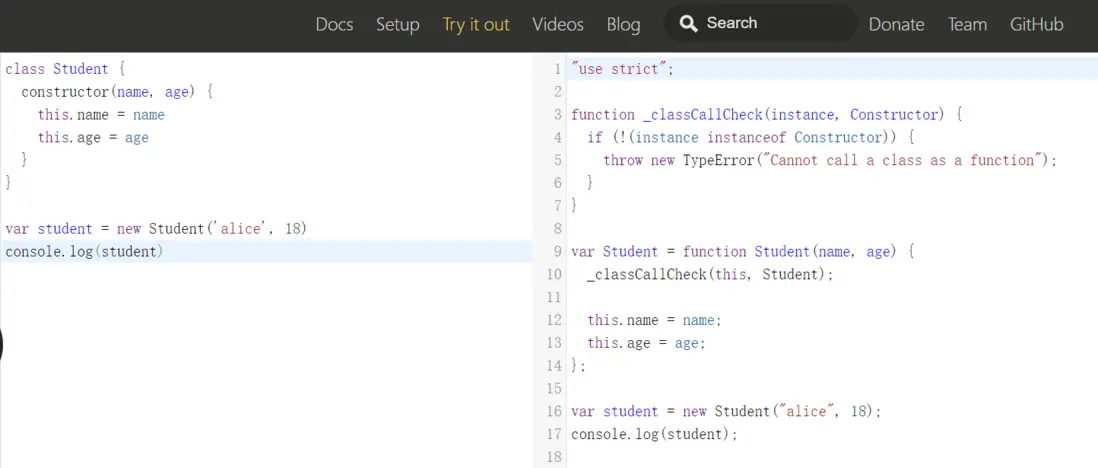定義
類是構造函數、原型鏈的語法糖。
定義類有兩種方式
class Student {
}
var Student = class {
}某些瀏覽器可能無法解析es6及以上的語法,這時候需要通過babel將代碼解析成瀏覽器可識別的語法,定義類的語法通過babel編譯之後就是通過function定義的構造函數。
類和構造函數是一樣的,通過new關鍵字創建,具有prototype屬性
class Student{}
var student = new Student()
console.log(Student.prototype)
console.log(Student.prototype.constructor)
console.log(student.__proto__ === Student.prototype)
console.log(student instanceof Student)
console.log(typeof Student)執行結果如下
類的方法
構造方法
通過constructor來定義類的構造方法,通過new關鍵字來創建類的實例時會執行構造方法中的代碼
class Student {
constructor(name, age) {
this.name = name
this.age = age
}
}
var student = new Student('alice', 18)
console.log(student)執行結果如下,創建了一個Student的實例對象
babel解析結果如下
實例方法
實例方法就是掛載在類(構造函數)原型上的方法,可以供所有的實例對象使用,不會在每個實例對象上保存一份
class Student {
constructor(name, age) {
this.name = name
this.age = age
}
studying() {
console.log(`${this.name} likes studing~`)
}
}
var student = new Student('kiki', 16)
console.log(student)
student.studying()執行結果如下
訪問器方法
訪問器方法可以用於獲取/修改類中的屬性
class Student {
constructor(){
this.mainSubject = 'Chinese'
}
get subject(){
console.log('獲取主修課')
return this.mainSubject
}
set subject(value){
console.log('修改主修課')
this.mainSubject = value
}
}
var student = new Student()
console.log(student)
student.mainSubject = 'Math'
console.log(student)執行結果如下
靜態方法
定義在類(構造函數)上,且僅供類(構造函數)自身可使用
class Student {
static showInfo(){
console.log('我是一個Student類')
}
}
Student.showInfo()執行結果如下
繼承
類中實現繼承要比構造函數中更為簡單,通過extends關鍵字就可以實現兩個類的繼承關係。
class Person{
eating(){
console.log('person eating')
}
}
class Student extends Person{
}
var student = new Student()
console.log(student)
student.eating()執行結果如下
如果要共享構造方法中的數據,則需要通過super來實現
class Person{
constructor(name, age){
this.name = name
this.age = age
}
eating(){
console.log('person eating')
}
}
class Student extends Person{
constructor(name, age, stuNo){
super(name, age)
this.stuNo = stuNo
}
eating(){
super.eating()
console.log('student eating')
}
}
var student = new Student('kiki', 16, 1)
console.log(student)
student.eating()執行結果如下
繼承內置類
當我們需要對javascript內置的函數做一些擴充的時候,可以繼承自內置的函數。比如對數組進行補充,新增一個返回數組中第一個元素的方法。
class iArray extends Array {
firstItem(){
return this[0]
}
}
let arr = new iArray(1, 2, 3)
console.log(arr)
console.log(arr.firstItem())執行結果如下
混入
javascript中只能單繼承,不支持多個父類,當子類希望獲取多個父類的屬性和方法時,可以自定義mixin的方式來實現繼承關係
function mixinRunner(BaseClass) {
return class extends BaseClass {
running() {
console.log('running')
}
}
}
function mixinEater(BaseClass){
return class extends BaseClass {
eating() {
console.log('eating')
}
}
}
class Person {
}
const Student = mixinEater(mixinRunner(Person))
const student = new Student()
student.running()
student.eating()執行結果如下
多態
不同的數據類型操作執行同一個操作時,表現出來的行為不一致,就稱為多態。
function calcArea(foo) {
console.log(foo.getArea())
}
var circle = {
radius: 6,
getArea() {
return this.radius * 3.14
}
}
function Person() {
this.getArea = function(){
return 20
}
}
calcArea(circle)
calcArea(new Person())執行結果如下
以上執行兩次calcArea函數,傳入的參數分別為普通對象和實例對象,執行他們各自的getArea方法,最後獲取的結果也不一樣
以上就是ES6之類(class)使用的具體介紹,關於js高級,還有很多需要開發者掌握的地方,可以看看我寫的其他博文,持續更新中~



























